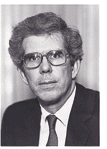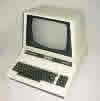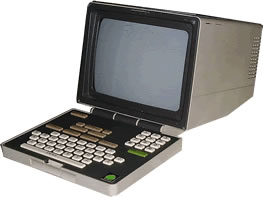click on the home button to go to the home page
|
The Industrial Era 1980 The Third Generation of computers starts approximately in this era. These computers are characterized by mainly electronic models but now fully programmable. A prototype of IBM's Personal Computer is constructed by a team under Don Estridge |
pre history | antiquity
| pre industrial era | industrial
era
| 1947 | 1950 | 1952 | 1955 | 1958 | 1961 | 1963 | 1965 | 1969 | 1970 | 1972 | 1974 | 1976 |
| 1978 | 1980 | 1981 | 1982 | 1984 | 1986 | 1989 | 1991 | 1993 | 1994 | 1996 | 2000 | 2002 |
| Related Articles |
| Related Resources |
|
history of videogames |
![]() Epson's
first dot matrix printer, TX-80 (80 from the number of columns
it printed per line), was introduced in 1978. However, this didn't attract
much attention - except from Commodore who used it as the system printer for
its PET computer. (51)
Epson's
first dot matrix printer, TX-80 (80 from the number of columns
it printed per line), was introduced in 1978. However, this didn't attract
much attention - except from Commodore who used it as the system printer for
its PET computer. (51)
![]() Matra Datavision is created as part of Lagardere Group and starts
to produce CAD/CAM software.(25)
Matra Datavision is created as part of Lagardere Group and starts
to produce CAD/CAM software.(25)
![]() Apple introduced Apple III for 3500 USD but is becomes a disaster.
Initially the machine suffered a nearly 100 % failure rate and almost dragged
down the company.(25)
Apple introduced Apple III for 3500 USD but is becomes a disaster.
Initially the machine suffered a nearly 100 % failure rate and almost dragged
down the company.(25)
![]() An
improved version, the MX-80 dot matrix printer,
began to be developed later in that same year. The TX-80 took three months to
develop. The MX-80 took about two years, was introduced in late 1980, quickly
became the best selling printer in the United States, and eventually became
the industrial standard for microcomputers. This was despite it being designed
not to produce graphics. Within a year the Graftrax version with graphics had
hit the streets.(51)
An
improved version, the MX-80 dot matrix printer,
began to be developed later in that same year. The TX-80 took three months to
develop. The MX-80 took about two years, was introduced in late 1980, quickly
became the best selling printer in the United States, and eventually became
the industrial standard for microcomputers. This was despite it being designed
not to produce graphics. Within a year the Graftrax version with graphics had
hit the streets.(51)
The printer established a new standard in high performance with low price for
printers and is created by Chris Rutkowski. (50)
![]() The
first Apple and TRS 80 clones appear on the market. Apples takes draconian measures
against cloning manufacturers.
The
first Apple and TRS 80 clones appear on the market. Apples takes draconian measures
against cloning manufacturers.
![]() Texas
Instruments made huge profits with its early calculators and now enters the
mini computer market with a machine based on the 16 bits TMS9900 chip. This
machine is fairly successful but has to compete with the big names like DEC
and Digital Research.
Texas
Instruments made huge profits with its early calculators and now enters the
mini computer market with a machine based on the 16 bits TMS9900 chip. This
machine is fairly successful but has to compete with the big names like DEC
and Digital Research.
 But TI is looking for another killing machine
that could sweep the exploding consumer market. This should be the TI99/A with
databus(36) of 8 bits.
But TI is looking for another killing machine
that could sweep the exploding consumer market. This should be the TI99/A with
databus(36) of 8 bits.
It is a technological marvel with connectors for a color monitor and a cassette
recorder. Programs are stored in ROM cassettes that can be plugged right into
the machine. But the price of 1200 US$ is very high when you realize that these
machines are intended for home users.
The success is less then expected and TI will redesign the TI99/A what will
result in the type 99/4A. The new model has a connection for a standard household
color TV, a better keyboard and BASIC is build in. This machine is successful
but appears too late on the market to claim a large chunk of the consumer market.
Pricing wars are in full strength and in 1983 TI will terminate the production.
But other producers will still make hard and software. It is one of those machines:
'That refuses to die'(37)
One curiosity: There was a PC-box for the TI 99/4a - a complete PC which could be connected to the TI. The only thing the TI got do for the PC were the keyboard inputs.(48)

![]() The
prototype of the IBM PC will be designed by a team of twelve people at IBM managed
by Donald Estridge.(2)
The design team used the Datamaster System/23 as an prototype or example. This
machine had diskdrives and a keyboard in one single housing. The prototype will
be delivered to Microsoft by a team member (David J. Bradley) in December to
make an Operating System for it.
The
prototype of the IBM PC will be designed by a team of twelve people at IBM managed
by Donald Estridge.(2)
The design team used the Datamaster System/23 as an prototype or example. This
machine had diskdrives and a keyboard in one single housing. The prototype will
be delivered to Microsoft by a team member (David J. Bradley) in December to
make an Operating System for it.

![]() To
stay competitive in the tearsome personal computer market Commodore releases
in July the model CBM 8000 series. A system with a 1 Megabyte (1Mb) disk and
a monitor that can have 80 characters or column on one row. The price is just
about a third of these sold by the competition and that it upset the market
may speak for it self.
To
stay competitive in the tearsome personal computer market Commodore releases
in July the model CBM 8000 series. A system with a 1 Megabyte (1Mb) disk and
a monitor that can have 80 characters or column on one row. The price is just
about a third of these sold by the competition and that it upset the market
may speak for it self.
This is the father of all
price wars ever in the future IT (Information Technology) industry.
![]() Seagate
Technology introduces the harddisk. This first born can store 5 Mb(38),
that are about 60 5.25" floppy disks. The access time is low: 180 - 240
milliseconds
Seagate
Technology introduces the harddisk. This first born can store 5 Mb(38),
that are about 60 5.25" floppy disks. The access time is low: 180 - 240
milliseconds
![]() The
optical disk is invented by Philips in the Netherlands. This disc can store
1.3 giga(39) bytes of information. The information
is "burned" into a thin metal layer (Gold, Silver or Aluminum) by
a laser. The little dimples(holes) that are burned into the metal layer are
representing binary information. With another type of laser these dimples are
translated back to information that can feed a computer. Philips and Sony announced
the first CD-DA (Digital Audio) device. The original specification is called
Red Book.
The
optical disk is invented by Philips in the Netherlands. This disc can store
1.3 giga(39) bytes of information. The information
is "burned" into a thin metal layer (Gold, Silver or Aluminum) by
a laser. The little dimples(holes) that are burned into the metal layer are
representing binary information. With another type of laser these dimples are
translated back to information that can feed a computer. Philips and Sony announced
the first CD-DA (Digital Audio) device. The original specification is called
Red Book.
![]() Hewlett
Packard does not want to stay behind in the Personal Computer race and releases
their version of a PC: HP-85
Hewlett
Packard does not want to stay behind in the Personal Computer race and releases
their version of a PC: HP-85
 |

![]() Voulez-Vous Taper Avec Moi?: The French launch
Minitel a text-only system accessible through
"dumb terminals" supplied by the phone company. Originally intended
to provide directory assistance and business information.
Voulez-Vous Taper Avec Moi?: The French launch
Minitel a text-only system accessible through
"dumb terminals" supplied by the phone company. Originally intended
to provide directory assistance and business information.
This is the first national
wide spread network which is accessible for every consumer in the world who
has a telephone connection. Probably the most remarkable fact is that Minitel
terminals are freely distributed by the state owned France telecom. In time
more than 30.000 services will be offered through this network including Electronic
Mail. Minitel almost immediately turns into a giant nonstop "hot chat".
Having pioneered the Net in their own special way, the French evidence little
interest in its progress for the next decade. (shown is
a modern minitel terminal, for lack of an "original" picture)
![]() IBM
constructs the first 1 Gigabyte Harddisk. Its size is as big as a large refrigerator,
weighs 150 kilo's and cost 40.000 USD
IBM
constructs the first 1 Gigabyte Harddisk. Its size is as big as a large refrigerator,
weighs 150 kilo's and cost 40.000 USD
![]() Satellite Software (later Word Perfect Corp.) announces
the first version of Word Perfect. By 1987 it will be the most dominant DOS
word processor program.
Satellite Software (later Word Perfect Corp.) announces
the first version of Word Perfect. By 1987 it will be the most dominant DOS
word processor program.
![]() First issue Call Apple and Nibble in 1980, dedicated
to the Apple II.
First issue Call Apple and Nibble in 1980, dedicated
to the Apple II.
![]()
| Last Updated on October 25, 2004 | For suggestions please mail the editors |
Footnotes & References